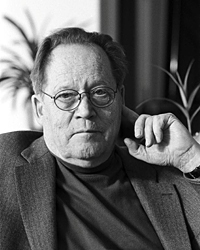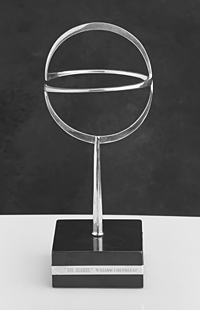Internationally acclaimed silversmith Heikki Seppä, professor emeritus in the Sam Fox School of Design & Visual Art’s College of Art, died May 18, 2010, at his home on Bainbridge Island, Wash. He was 83.

One of the most innovative and influential silversmiths of the latter 20th century, Seppä helped introduce the technique of reticulation to the United States while also developing and popularizing new methods for shaping sheet metal into three-dimensional shell structures. His own works are notable for their use of bold sculptural forms — Seppä insisted that silver could be an expressive, rather than merely utilitarian, medium — and for combining silver and gold with other metals to create striking contrasts and color blends.
Born in Säkkijärvi, Finland, in 1927, Seppä studied at the Goldsmith School of Helsinki and the Central School of Industrial Art in Helsinki. He continued his professional training in 1948-49 with George Jensen Silversmiths in Copenhagen, Denmark, and two years later emigrated to British Columbia, Canada, where he taught jewelry and metalsmithing at the Civic Center in Prince Rupert.
Seppä came to the United States in 1961, studying at the Cranbrook Academy of Art in Bloomfield Hills, Mich., and teaching at the Art Center School in Louisville. In 1963, he earned a Master’s Status, Silversmith (equivalent to an MFA degree), from the Finnish Ministry of Education and, in 1965, joined the faculty of Washington University, where he led the metalsmithing program until his retirement in 1992.

Search Award
Seppä’s jewelry, hollowware and sculpture are included in hundreds of public and private collections, including those of the Saint Louis Art Museum and the Renwick Gallery of the Smithsonian Institution. Notable local commissions include a group of 14 ecclesiastical objects for the Church of St. Michael & St. George as well as a menorah, Sabbath candleholder and eternal light for Congregation Shaare Emmeth. Each year, Washington University’s William Greenleaf Eliot Society presents a silver replica of Seppä’s sculpture “The Search” to the recipient of its Search Award, the society’s highest honor.
In addition to his teaching and studio work, Seppä authored two significant books: Form and Emphasis for Metalsmiths (1978), which literally redefined the formal vocabulary of contemporary metalsmithing, and Hopeasepän Pajasta (1998), the first silversmithing book written in Finnish.
“A thorough knowledge of materials and techniques is a direct measure of artistic freedom,” Seppä wrote in the preface to Form and Emphasis, which has remained in print for more than three decades. “The fewer technical problems that artists must solve, the more spontaneous their art will be.”
In 1987, Seppä was proclaimed a national treasure by the American Crafts Council and, in 1992, received a Gold Medal for Meritorious Lifetime Achievement from the League of Finland Goldsmiths. Other honors include an Excellence in the Arts Award from the Art and Education Council of St. Louis (1996), a Hans Christensen Sterling Silversmith’s Award from the Society of American Silversmiths (2003) and a Lifetime Achievement Award from the Society of North American Goldsmiths (2008).
Seppä is survived by his wife, Laurie A. Lyall.